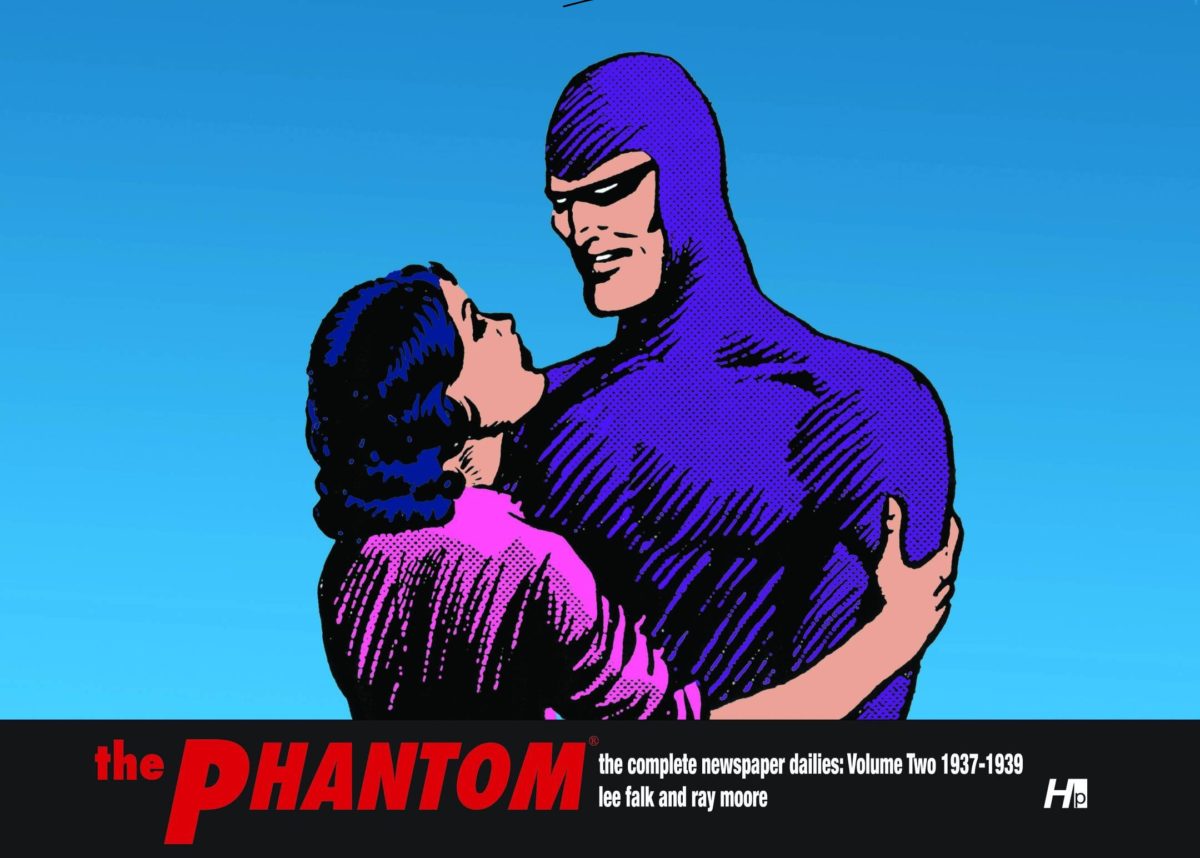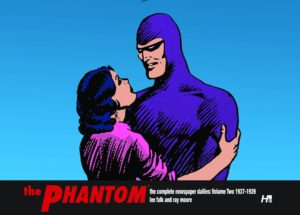Comic Strip Review: The Phantom: The Complete Newspaper Dailies: Volume Two 1937-1939 written by Lee Falk, art by Ray Moore
Almost five hundred years ago, a sailor named Christopher Walker was accompanying his father on that man’s last voyage when they were attacked by the Singh Brotherhood, a bloodthirsty band of pirates. The pirates killed the rest of the crew, but Christopher survived and washed up on a beach in Bangalla. The native Bandar people, pygmies who were known as the Poison People because of their knowledge of botany and chemistry, healed the young man and brought him to the Skull Cave, supposed home of their god.
Donning ceremonial garb modeled on that vengeful spirit, young Walker became a Phantom, a Ghost Who Walks. He destroyed that iteration of the Singh Brotherhood and vowed on the skull of his father’s murderer to oppose all forms of piracy and injustice. When the Phantom died, his son took his place, and in each generation, another son takes over the role, creating the illusion that the Phantom cannot die.
This long-running comic strip was created by Lee Falk in 1936, two years after creating the also-successful Mandrake the Magician. Skilled artist Ray Moore brought the characters to life. In the first story the proto-superhero succeeds his father, who has been treacherously slain by a member of the Singh Brotherhood. (In the early stories, Bangalla is near India, but has wildlife and native customs closer to Africa at times–later on the country would move to sub-Saharan Africa.) Also early on, the Ghost Who Walks also meets Diana Palmer, who becomes the love of his life.
This volume opens with the Phantom engaging in a bit of stagecraft (with the connivance of the local witch doctor) to perform his annual duty of acting as judge for a village’s disputes. The witch doctor turns out to be aware that the Phantom is actually a series of men, but finds it useful to pretend otherwise to keep the superstitious natives in line. During his visit, the Phantom realizes that village boy Toma is actually a white kid who’s been disguised as a native via skin dye by his purported father.
Somehow, the other villagers had never cottoned on to this, but in retrospect they admit having some suspicions about Beeli’s behavior and excellent cash flow despite being the laziest man around.
The Phantom takes Tommy Reynolds to England, to search for answers as to why he was sequestered in that native village for years. There turns out to be a convoluted reason for the bizarre events, but justice is served and there’s a bittersweet ending.
After that, Diana’s meddling mother pressures the young woman into marrying one of her more suitable suitors, as it’s unlikely the masked man Diana loves will ever turn up again. Diana’s mother is wrong, but before the Phantom and Diana can tie the knot, the British government alerts the Phantom to an emergency situation in the Himalayas that only he can solve! (The star-crossed lovers wouldn’t finally get hitched until the 1970s.)
The Himalayas situation resolved, the Phantom is on his way back to Diana when he’s waylaid in Algiers. Mrs. Palmer successfully meddles by preventing the lovers’ communications from reaching each other, making each think the other has broken off the relationship.
The next story introduces Baron Grover, a modern-day pirate who would become a recurring foe of the Phantom. Grover is an actual nobleman who began piracy as a lark, only to lose all his money and thus take up the profession seriously. The Phantom has a lot of fun making it appear that he truly is immortal; this is also the first time we learn that supposedly seeing the Phantom’s real face is lethal.
Back in Bangalla, a white trader is forcing natives to become pearl divers for him, overworking them and ruining their health. Roark turns out to be trickier to deal with than he should be, as he has not only bought off the local law, but the Phantom becomes mistakenly convinced that Diana is now Roark’s wife!
The final story in this volume has the Phantom saving Diana from slave traders in North Africa–in a story where they never actually meet! Comic relief is provided by an elderly hermit who is getting more visitors in a few days than he’s had in the last forty years; and could probably resolve the romantic subplot in seconds if he were told a few pertinent details.
This is great adventure strip stuff, with Lee Falk working out just how this masked hero thing works, and getting the balance of action, humor and romance right. Over the short term, the separation of the Phantom and Diana creates a nice tension, and the misunderstandings and missed connections draw out the relationship nicely.
Because of the period it was written in, there’s some unfortunate stereotyping of native peoples, a certain amount of presumed white superiority and a bit of period sexism. (Played for laughs in the case of the hermit–“women get fat when they have children, therefore I do not regret escaping the bonds of matrimony!”)
Recommended to adventure lovers, those interested in the roots of costumed hero comics, and well worth checking out at your library!


